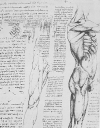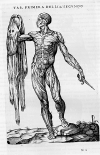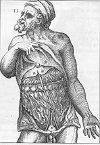
A HISTORY OF MUSCLES
"The power of locomotion is that which contracts and relaxes the muscles whereby the members and joints are moved, extended or flexed. This power reaches the limbs by way of the nerves and there are as many forms of power as there are of movement. Each muscle has its own peculiar purpose and it obeys the decree of the composite sense." -- Avicenna, early 11th century
Muscles require, perhaps, less explanation in relation to other parts of the body: most larger muscles are readily visible beneath the skin and their role in the movement of the body was relatively easy to understand. Perhaps because of this fact, careful investigation of the muscles was relatively lacking in ancient and medieval anatomy. Look at the medieval anatomical image below. How are the muscles portrayed in relation to other parts of the body?
 You might contrast the drawing of the hand below in the
twelfth century with the very detailed image of the hand, in imitation of
Vesalius, above, engraved about five hundred years later. The contrast is
striking. Think about the words that the Scottish medical student John Moir
wrote down in 1620, echoing the mediavel tradition of knowing the origins of
words as a means of anatomizing the body: "Muscle is so called either because of a similarity to the
shellfish, or because it resembles a skinned mouse. Muscle is also called lacertus
because it resembles a lizard in color and shape."
You might contrast the drawing of the hand below in the
twelfth century with the very detailed image of the hand, in imitation of
Vesalius, above, engraved about five hundred years later. The contrast is
striking. Think about the words that the Scottish medical student John Moir
wrote down in 1620, echoing the mediavel tradition of knowing the origins of
words as a means of anatomizing the body: "Muscle is so called either because of a similarity to the
shellfish, or because it resembles a skinned mouse. Muscle is also called lacertus
because it resembles a lizard in color and shape."
The late fifteenth and sixteenth
centuries were an era of great fascination with musculature. Leonardo
da Vinci, like many Renaissance artists devoted a good portion of his life to
the drawing of male nudes in motion. His images suggest the implicit
appeal of examining muscles by combining observations of the living with
dissections of the dead. Look at the two drawings below. Can you
tell what Leonardo wanted to understand about the body from them? How does
he combine artistic and scientific perception?
Leonardo
da Vinci, like many Renaissance artists devoted a good portion of his life to
the drawing of male nudes in motion. His images suggest the implicit
appeal of examining muscles by combining observations of the living with
dissections of the dead. Look at the two drawings below. Can you
tell what Leonardo wanted to understand about the body from them? How does
he combine artistic and scientific perception?
Leonardo's images of muscled nudes were
primarily for his private study or were preparatory sketches for  some
of his famous paintings such as The Last Supper. Yet we can see an
interesting interplay between artists' sketchbooks and published anatomical
treatises at the beginning of the sixteenth century. Jacopo Berengario da
Carpi's famous Commentary on the Anatomy of Mondino (1521) contained a
series of striking images such as the one here. By
comparison, such images seem highly stylized and non-specific about the actual
musculature. Yet both indicated the power of the anatomist to reveal what
lay just beneath the skin.
some
of his famous paintings such as The Last Supper. Yet we can see an
interesting interplay between artists' sketchbooks and published anatomical
treatises at the beginning of the sixteenth century. Jacopo Berengario da
Carpi's famous Commentary on the Anatomy of Mondino (1521) contained a
series of striking images such as the one here. By
comparison, such images seem highly stylized and non-specific about the actual
musculature. Yet both indicated the power of the anatomist to reveal what
lay just beneath the skin.
With the publication of Andreas Vesalius'
On the Fabric of the Human Body (1543), the muscle man became, along with
the skeleton, an emblem of the new anatomy. Vesalius took his readers
through a detailed visual unveiling of the muscles in Book Two. He not
only differentiated the muscles in some detailed but used illustrations, such as
the one to your right, to convey the subtle ways in which human and animal
anatomy could intermingle. Look closely at the muscle in the right leg,
just above the knee labeled "x." Is it human? Why do you
think Vesalius included it in this illustration?
along with
the skeleton, an emblem of the new anatomy. Vesalius took his readers
through a detailed visual unveiling of the muscles in Book Two. He not
only differentiated the muscles in some detailed but used illustrations, such as
the one to your right, to convey the subtle ways in which human and animal
anatomy could intermingle. Look closely at the muscle in the right leg,
just above the knee labeled "x." Is it human? Why do you
think Vesalius included it in this illustration?
 In
the 1550s, a Spanish anatomist, Juan Valverde, took the fascination with muscles
as a
symbol of what the body might reveal to new heights. Vesalius had made the
muscles seems to fall away from the body in a series of strikingly posed muscle
men set against the backdrop of Renaissance Padua. Valverde and his
engravers collapsed the distinction between the dissector and the dissected by
portraying dissection as a self-mutilation
In
the 1550s, a Spanish anatomist, Juan Valverde, took the fascination with muscles
as a
symbol of what the body might reveal to new heights. Vesalius had made the
muscles seems to fall away from the body in a series of strikingly posed muscle
men set against the backdrop of Renaissance Padua. Valverde and his
engravers collapsed the distinction between the dissector and the dissected by
portraying dissection as a self-mutilation -- a violent inquiry into one's own
body. His images portrayed the ancient adage, Nosce te ipsum (know
thyself), suggesting how strongly the muscle man had come to signify the moral dimensions of human anatomy.
-- a violent inquiry into one's own
body. His images portrayed the ancient adage, Nosce te ipsum (know
thyself), suggesting how strongly the muscle man had come to signify the moral dimensions of human anatomy.
By the early seventeenth century physicians focused less on the cultural meaning of a man without his skin and began to pay more attention to the actual structure of muscle itself. Fundamentally, this new interest in the muscles related to a widespread fascination about the nature of motion, not only in the body but in the world at large. As physicians and philosophers began to create more mechanistic theories of the body, a study of the musculature became an inquiry into the mechanisms of the body. Let us consider, for example, how William Harvey in his Lectures on the Whole of Anatomy (1653), built upon the detailed investigations of early Renaissance anatomists to create a rather different picture of the body: "[Muscle] fibers [are] for the sake of motion, sinews, threads. Straight: [1] long longitudinally opening by contraction [2] transverse compressing by contraction. The oblique are unable to detain by tonic motion, because [according to] Fallopius the straight are opened and the transverse are not compressed, by contraction."
Such an account does not quite go as far as Descartes' description of muscles and tendons as "devices and springs which seem to set [nerves] in motion." It was Descartes who, in his Treatise on Man (written between 1629 and 1633 and published in 1664), provided the ingredients for an utterly mechanist view of the body when he wrote: "I suppose the body to be nothing but a statue or machine made of earth, which God forms with the explicit intention of making it as much as possible like us." In the hands of certain readers, it was easy to remove God entirely from the picture, examining the body as if it were truly a machine -- brute matter in motion.
QUESTIONS: WHAT ROLE MIGHT ART HAVE PLAYED IN RENEWING INTEREST IN THE MUSCLES? HOW DID MUSCLES CEASE TO SYMBOLIZE THE SUPERNATURAL POWER OF THE BODY AND BECAME AN IMAGE OF ITS MACHINE-LIKE QUALITIES?